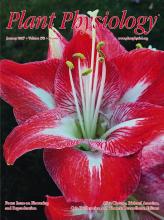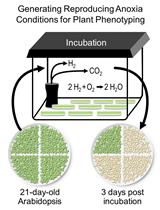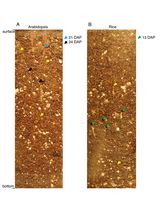- EN - English
- CN - 中文
Rice Lamina Joint Inclination Assay
水稻叶节夹角测定
(*contributed equally to this work) 发布: 2017年07月20日第7卷第14期 DOI: 10.21769/BioProtoc.2409 浏览次数: 13066
评审: Marisa RosaLaia ArmengotYuko Kurita
Abstract
Brassinosteroids (BRs) promote rice lamina inclination. Recently, we showed that OsBUL1 knockout mutant rice (osbul1) is defective in brassinosteroid signaling (Jang et al., 2017). To show that lamina joint inclination of osbul1 is less-sensitive than WT to exogenous brassinolide (BL) treatment in the lamina joint inclination bioassays, we applied the protocol presented below. The protocol focuses on: (1) how to prepare rice samples for the assay, and (2) how to treat BL exogenously. Finally, we have added a result showing lamina inclination between WT and osbul1 in BL solutions of various concentrations.
Keywords: Bioassay (生物测定)Background
The rice lamina joint connects the leaf blade and sheath, contributing significantly to the leaf angle trait and BR is the main regulator of the trait, while other plant hormones, including ethylene, gibberellin, and auxin, also influence leaf angle (Gan et al., 2015). A more erect leaf facilitates the penetration of sunlight, enhancing photosynthetic efficiency and occupying less space in dense planting (Sakamoto et al., 2006). Thus, rice lamina inclination is one of the major agronomic traits affecting rice plant architecture. Actually, the rice lamina inclination assay developed mainly by Wada and his co-workers is a highly specific and sensitive bioassay for BRs (Wada et al., 1981 and 1984). In this bioassay, treatment with BRs induces greater cell expansion of adaxial cells relative to the abaxial cells in the joint regions, causing laminar inclination in a concentration-dependent manner (Takeno and Pharis, 1982; Cao and Chen, 1995). Changes in cell wall extensibility or loosening are essential for cell expansion (Campbell and Braam, 1999). Although the molecular mechanism for such action remains elusive, cell wall loosening enzymes including xyloglucan endotransglycosylase have been shown to be upregulated by BL and involved in this modification, resulting in laminar inclination in rice (Uozu et al., 2000). Thus, here we describe a procedure through which we could distinguish the BR sensitivity between the wild type and erect leafed osbul1 mutant plants through the rice lamina inclination assay.
Materials and Reagents
- 250 µl pipette tips (Mettler-Toledo International, Rainin, catalog number: 17007479 )
- 1 ml pipette tips (Mettler-Toledo International, Rainin, catalog number: 17001121 )
- 50 ml SuperClear centrifuge tube (Labcon, catalog number: LAB3181 )
- Filter paper (Advantec, No.1: 90 mm)
- Petri dish, round, 90 x 15 mm (Alpha Plus, catalog number: 16001-1 )
- 50 ml syringe (Sigma-Aldrich, catalog number: Z124990 )
- Syringe filter (VWR, catalog number: 89041-306 )
- Micropore tape (3M, catalog number: 1530-0 )
- 1 ml tubes
- Rice seeds: Orysa sativa spp. japonica cv. Hwayoung and OsBUL1 knockout mutant rice (osbul1)
- Ethanol (Avantor Performance Materials, J.T. Baker®, catalog number: 8006 )
- Sodium hypochlorite (NaOCl, Commercial Bleach–CLOROX)
- Tween 20 (Alfa Aesar, Affymetrix/USB, catalog number: J20605 )
- Potassium hydroxide (KOH) (SHOWA, catalog number: 1637-0150 )
- Murashige & Skoog basal medium with Vitamins (MS) (PhytoTechnology Laboratories, catalog number: M519 )
- Sucrose (Alfa Aesar, Affymetrix/USB, catalog number: J21938 )
- Phytogel (Sigma-Aldrich, catalog number: P8169-500G )
- Brassinolide (BL) (Sigma-Aldrich, catalog number: E1641 )
- Sodium hypochlorite solution (with final available chlorine of 2%) (see Recipes)
- 5 N potassium hydroxide (KOH) solution (see Recipes)
- Murashige & Skoog (MS) media (see Recipes)
- 1 mM Brassinolide (BL) stock solution (see Recipes)
Equipment
- Rice husker (KETT ELECTRIC LABORATORY, model: TR-130 )
- Ultrasonic cleaner (Elma, model: E-30H )
- Clean bench (Chu-An, model: MBH-420N )
- Scissors (Basic Life, catalog number: 76000 )
- Forceps (Basic Life, catalog number: BL6502 )
- Growth chamber (CHANG KUANG, model: CK-68EX )
- Digital camera (Sony, model: NEX-3N )
- Protractor (Taiwan united stationery, catalog nunber: HA401 )
- 600 ml beaker (DWK Life Sciences, DURAN, catalog number: 21 106 48 )
- Glass petri dish (Sun Chion, catalog number: B16A1-0090 )
- Autoclave
- 10 ml measuring cylinders (DWK Life Sciences, DURAN, catalog number: 21 390 08 04 )
- 100 ml measuring cylinders (DWK Life Sciences, DURAN, catalog number: 21 390 24 02 )
- 500 ml measuring cylinders (DWK Life Sciences, DURAN, catalog number: 21 390 44 03 )
- Vortex mixer (Vortex-Genie2, Scientific Industries, model: Model G560 )
- Incubator (YIHDER TECHNOLOGY, model: LM-570RD )
- Pipetmans (Gilson, models: P20 , P200 and P1000 )
- RiOsTM Essential 16 Water Purification System (EMD Millipore, model: RiOsTM Essential 16 )
- Summit Series Analytical Balance (Denver Instrument, model: SI-234 )
- pH meter (UltraBasic Benchtop pH Meter, Denver Instrument, model: UB-10 )
Software
- ImageJ (https://imagej.nih.gov/ij/) for lamina angle measurement
Procedure
文章信息
版权信息
© 2017 The Authors; exclusive licensee Bio-protocol LLC.
如何引用
Readers should cite both the Bio-protocol article and the original research article where this protocol was used:
- Li, H., Wang, H. and Jang, S. (2017). Rice Lamina Joint Inclination Assay. Bio-protocol 7(14): e2409. DOI: 10.21769/BioProtoc.2409.
- Jang, S., An, G. and Li, H. Y. (2017). Rice Leaf Angle and Grain Size Are Affected by the OsBUL1 Transcriptional Activator Complex. Plant Physiol 173(1): 688-702.
分类
植物科学 > 植物生理学 > 表型分析
植物科学 > 植物生物化学 > 植物激素
生物化学 > 其它化合物 > 植物激素 > 油菜素类固醇
您对这篇实验方法有问题吗?
在此处发布您的问题,我们将邀请本文作者来回答。同时,我们会将您的问题发布到Bio-protocol Exchange,以便寻求社区成员的帮助。
Share
Bluesky
X
Copy link













